Twenty Two Questions on Simple Mechanism
Question.1. Define open pair.
Answer.
When two links of a kinematic pair are not held together mechanically, but remain in contact with each other under the action of force of gravity or some spring action, then such a pair is called an open pair. e.g., cam and follower as shown in figure are in contact due to force of gravity and the forces exerted by the spring.
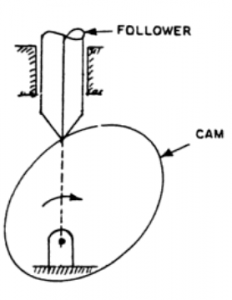 Fig. Cam and Follower
Fig. Cam and Follower
Question.2. Define closed pair.
Answer.
When two links of a kinetic pair are held together mechanically, in such a manner that only the required type of relative motion occurs, they are called closed pair. All lower pairs and some higher pairs are closed pairs. Example : enclosed cam and follower makes a closed pair.
Question.3. Define sliding pair.
Answer.
When two links of a kinematic pair are connected in a such a way that one link slides relative to another, the pair is called a sliding pair. As a sliding pair has surface contact between its links, so it is kind of lower pair. The Rectangular rod in a rectangular hole as shown in figure can be said as sliding pair if the two are having sliding motion relative to each other.
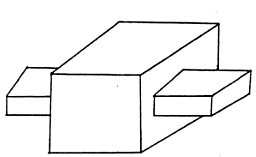
Fig. Sliding Pair
Question.4. Define turning pair.
Answer.
When two links of a kinematic pair are connected in such a way that one link can only turn or revolve about the fixed axis of another link, the pair is called a turning pair. e.g., a shaft revolving in a bearing with the collars at both the ends as shown in the figure.
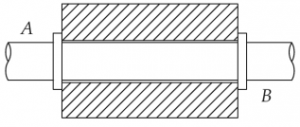
Fig. Screw pair
Question.5. Define rolling pair.
Answer.
When two links of a kinetic pair are connected in such a way that one link rolls on another link, the pair is called a rolling pair. e.g., balls rolling in the bearing, wheel rolling on the surface of the earth,are the examples of the rolling pair.
Q.6. Define screw pair.
Answer.
When two links of a kinematic pair is connected in such a way that they have turning as well as sliding motion relative to each other. One turns about the another link by means of threads, the pair is called the screw pair. e.g., lead screw of a lathe, another example of screw pair is shown in the figure below.
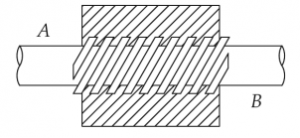
Fig. Screw Pair
Question.7. Define spherical pair.
Answer.
When two links of a kinematic pair are connected in such a way that one link in the form of sphere turns or swivels about another fixed link, the pair is called spherical pair. for this pair the degree of freedom is three which allows independent relative rotations about the three separate concurrent axis. e.g., ball and socket joint.
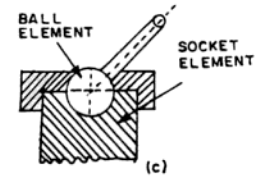 Fig. Ball and socket joint
Fig. Ball and socket joint
Question.8. Define kinematic chain
Answer.
It is a combination of kinematic links in space which are so connected that the relative motion between the links is completely or successfully constrained and the last link is connected to the first link. Minimum number of links to form a kinematic chain are three as shown in the figure (a) given below. Since no relative motion is possible between these links, it forms a structure. So we require four links to form a simplest kinematic chain as shown in the figure (b).
 Fig. (a)
Fig. (a)

Fig (b)
Question.9. Define mechanism.
Answer.
Mechanism is basically an assembly of resistant links which are connected in such a way that they have completely or successfully constrained relative motion between them. A mechanism can be obtained by fixing one of the links of a kinematic chain. It can also be defined as the system of bodies designed to covert the motion of, and the forces on, one or several bodies into constrained motion of, and the forces on, the other bodies. When we deal with the mechanism the specific task to which it is assigned is not important, whether it is a shaping machine or internal combustion engine. The emphasis is on the motion and force of the system and they may be applicable on any machine in which the specific mechanism can be employed.
Question.10. Define equivalent mechanism.
Answer.
In plane mechanisms, the turning pairs can be replaced by other types of pairs like sliding pairs etc.
The new mechanism obtained by replacing one kinematic pair with the other so that the degrees of freedom of the new mechanism are same as that of original mechanism is called equivalent mechanism.
Question.11. Define inversion of mechanism.
Answer.
A mechanism is obtained by fixing one of the links of a kinematic chain. If any other link of the mechanism is fixed instead of the original one the new mechanism so obtained is termed as inversion of the previous mechanism.
Question.12. Name different types of kinematic chains.
Answer.
- Four bar chain or Quadric cycle chain,
- Single slider crank chain.
- Double slider crank chain.
Question.13. What is a four bar chain?
Answer.
It is made up of four rigid links which are connected to form a quadrilateral by four pin joints as shown in figure.
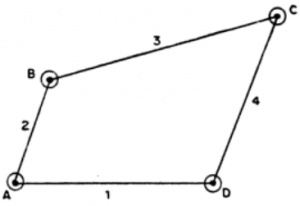
Fig. Four bar chain
Question.14. What is the use of crank and lever mechanism?
Answer.
The mechanism is used for converting rotary motion into reciprocating motion.
Question.15. What is the use of double crank mechanism?
Answer.
The mechanism is used to transmit rotary motion of one wheel to another wheel.
Question.16. What is double lever mechanism?
Answer.
Figure shows a four bar chain in the form of a parallelogram. The link 1 is fixed. This is used in pantograph which is a copying device. The exact motion of any link in the enlarged or reduced scale can be obtained with the help of this device.
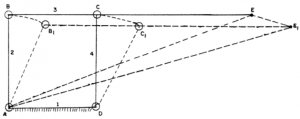 Fig. Pantograph
Fig. Pantograph
Question.17. What is slider crank chain?
Answer.
It is a four bar chain having one sliding pair and three turning pairs. This mechanism is used to convert reciprocating motion of piston into rotary motion of crank in case of an internal combustion engine or rotary motion of a crank into reciprocating motion of piston in case of a reciprocating compressor.
Question.18. Name different types of slider crank chain.
Answer.
Pendulum pump, oscillating cylinder mechanism, crank and slotted lever quick return motion mechanism, gnome engine.
Question.19. What is double slide crank chain.
Answer.
A four bar chain with two turning pairs and two sliding pairs is known as double slider crank chain. Two die blocks slide along two slots at 90 degree in a frame and the pins P and Q on the die blocks are linked by the link PQ. Each of the die block forms a turning pair with the link PQ and the sliding pair with the frame.
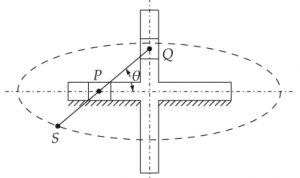
Fig. Double Slider Crank (Elliptical Trammel)
Question.20. Name the inversion of double slider crank chain.
Answer.
Its inversions are:
- Elliptical trammel,
- Oldham’s coupling,
- Scotch yoke mechanism.
Question.21. What is elliptical trammel?
Answer.
An elliptical trammel is a simple mechanism which can race an exact elliptical path. it is also known as ‘Elliptic Trammel’ or ‘Trammel of Archimedes’. It consists of two shuttles which are confined (trammelled) to perpendicular channels or rails, and a rod which is attached to the shuttles by pivots at fixed positions along the rod.
Question.22. What is Oldham’s coupling?
Answer.
It is meant for transmission of power from one shaft to another shaft parallel to each other when the distance between the two axes is small and variable. The shafts are connected in such a way that if one rotates, the other shafts rotates at the same speed and in the same direction.
2 Responses to “Twenty Two Questions on Simple Mechanism”
Nikhil Saraswat
Good choice of questions & their simple answer
Nikhil Saraswat
Simple answer of questions